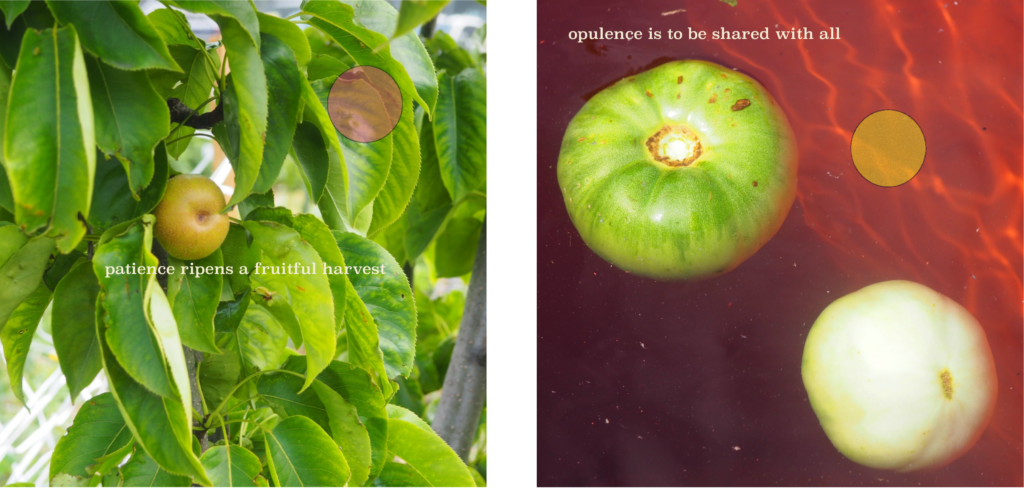It may seem hard to believe—what, with the splendors of late-summer produce still calling out to us from farm stands and grocery store aisles and Instagram feeds—but it’s officially Fall, in the Northern Hemisphere at least.
In this issue, three contributors contemplate what the change in seasons—and specifically the harvest season that accompanies the autumnal equinox— means for their kitchen tables; their livelihoods; their personal growth.
Chef and restaurant owner Amanda Shulman waxes poetic about the art of the late summer dinner party; chef Tara Thomas shares a visual representation of the earth’s cycles of opulence; and cannabis professional and cookbook author Mennlay Golokeh Aggrey chronicles her evolving relationship with the natural world.
We hope that their pieces plant seeds of inspiration and self-reflection within you, as they have with us.
Alex & Ally
There’s something special about dinner parties. A communal table, a shared loaf of bread, a pitcher to pour and pass amongst familiar and unfamiliar faces.
The pandemic has had me longing for nights that tumble into early mornings filled with crumbs and stained napkins and impromptu dances and sips of amaro that nobody needs. Nights filled with and centered around food and table games, jousts and conversation, elaborate dishes, simple dishes, dips and pies. I missed it so much that I built a restaurant around it, bringing the beauty of a dinner party to a restaurant’s stage in the way I knew best.
The most important part of a dinner party is making sure that you get to partake in both the dinner and the party. Don’t make it too complicated. Be planful; let others participate by passing a bowl of lightly sweetened cream around the table along with a whisk, and allow your guests to take turns whipping the cream into soft peaks. Give your friends the chance to say that they helped.
Amanda Shulman
The key to a successful dinner party is all in a balanced menu—pick one thing to be hot and allow the rest to be room temperature or chilled. A thoughtful menu allows you to provide the dinner without missing the party.
Summer has extended itself into the early autumn months, giving us the gift of swollen peaches and plump tomatoes unusually late in the game. Salt these gifts generously and let them shine.
I always start with a spread and taper the meal into smaller courses—a lavish table of crackers and dips and crudité lends to long grazing and light lifting. Serve plenty of bread and too much butter. Follow your spread with a few cold salads (like the one below) that can be made before your friends arrive. Maybe throw a steak on the grill or a rack of ribs in a low heated oven, or a simple pasta in a pan (perhaps zucchini cacio e pepe?). By the time the main course rolls around, remember your guests have enjoyed ¾ of their dinner and it’s your turn to party.
When it comes to dessert, think cake, but easy. Grab whatever fruit you can find and tuck it into an almond brown butter cake, which sounds fancier than it is. It’s 50% cake and 50% fruit, so you should feel good about devouring it. The kicker? It tastes even better if you make it the day before.
Chilled melon salad with tomatoes, peaches, and pepper vinaigrette
Ingredients
For the vinaigrette
1 red bell pepper, seeded
1 yellow bell pepper, seeded
1 tsp mustard seeds
1 tbsp salt
1 tsp sugar
5 black peppercorns
½ cup vinegar
⅓ cup water
Olive oil
Neutral oil, like canola
1 sprig fresh basil
For the salad
1 cantaloupe or any orange melon, cut into wedges (skin on, if that’s your vibe)
1 heirloom tomato, cut into chunks
1 peach, thinly sliced into half moons
Fresh basil
Method
First you’ll pickle the peppers for your vinaigrette—this can be done up to a week ahead of time.
Bring the vinegar, water, salt, sugar, peppercorns, and mustard seeds to a rapid boil in a medium saucepan on the stove. Add your peppers, and boil until tender.
When tender, transfer your peppers to a container or vessel. *KEEP THE PICKLING LIQUID!* Submerge the peppers in oil—half olive oil and half neutral oil—until just covered, and add a heaping spoonful of your pickling liquid. Add a whole sprig of basil—leaves and stem and all—and let it cool. Let this marinate overnight, and use it for days to come.
To make the vinaigrette—toss the pickled peppers in a food processor and pulse, or mince by hand. Thin out with a little of the preserving liquid and add more pickle liquid from your reserves, to taste.
Toss with the tomato chunks and peach slices.
Salt your melon. Dress with the pepper/peaches/tomato situation, and top with torn fresh basil.
Brown Butter Fruit Cake
Ingredients
Use peaches, blackberries, blueberries, raspberries…you get the idea.
4 cups fruit—if using stone fruit, cut into 2-inch chunks or half moons; if using berries, leave whole
1 ½ cups granulated white sugar
1 cup browned butter (2 sticks of butter, toasted over low heat until golden and foamy and scented of butterscotch), cooled to room temperature
4 eggs
½ cup almond meal
1 ½ cups flour
Pinch of salt
1 ½ tsp baking powder
Granulated brown sugar, for topping
Method
Preheat oven to 350℉. Whisk together the butter and sugar until fluffy. This takes some arm strength! Once pale and fluffy, add in the eggs and continue whisking furiously. Combine the dry ingredients together and fold them in, plopping them into the bowl in one fell swoop. Your mixture should be thick like muffin batter and smell like butterscotch.
Grease a circular cake pan. Put the batter in the pan and top with your fruit, placing itin to basically cover the cake. The fruit doesn’t have to be totally submerged—the cake will envelope it. Top with a generous sprinkle of brown sugar. Bake for 30–40 minutes, rotating the pan at the 20 minute mark. The cake is done when a knife is inserted in the center and comes out clean, or just do the jiggle test and see that the center is totally set. Cool completely before removing from the pan.
About Amanda Shulman
Amanda Shulman is the chef and owner of Her Place, a dinner-party-style-not-restaurant in Philadelphia. She formerly worked at Vetri Cucina in Philadelphia, and Momofuku Ko and Roman’s in New York. She spent 6 months cooking in Bergamo, Italy; moved to Las Vegas to be the opening executive sous chef at Vetri’s eponymous spot at the Palms; and ventured to Montreal to fall in love with everything French and meaty at Joe Beef. She loves bread with her butter, and all pickles.
Tara Thomas
To celebrate life you must nourish your body with food from our Earth.
About Tara Thomas
Through raising awareness and activating space, chef Tara Thomas aims to change our relationship with food. The kitchen, land, media, and community presence inspires her to foster a space of empathy. Tara asks us to look at our privilege within our relationship to food, and think about how we can show up better for those marginalized through radical agriculture and community care through action.
I spent my formative teenage years in central Pennsylvania’s Amish country, in a dairy town where rhubarb, apples, celery, strawberries, corn, tobacco, and mushrooms were harvested in bounties. But instead of being attuned to the natural world around me, I was more interested in my adolescent micro-world of 90s R&B, journaling, and daydreaming.
This dynamic changed in 2005, when I quit my office job to step into the shadows of cannabis cultivation in Humboldt County, California—North America’s weed paradise—and become a professional commercial indoor grower.
During this pivotal turning point in my life, my relationship to and appreciation for ancient agricultural practices deepened. I learned to ride the rhythms of seeding, growth, pruning, harvesting, tilling, and replanting. Growing weed was my high stakes crash course on botany and horticulture.
Indoor cultivation tasks often dictated time—the day of the week could be determined based on the plant’s watering schedule. I spent countless hours dipping plant roots into growth hormones; walking through narrow aisles of larger-than-life plants to inspect for almost microscopic pests; brewing musty compost tea. All of these rhythmic chores eventually led to the culminating moment when I would kneel in quiet ceremonious gratitude before cutting down the plants’ stalks to harvest.
Outdoor, sun-grown harvests, meanwhile, were a different affair. Despite how much control the head grower might have over her crops, the unpredictable and wild elements of nature left growers and the cannabis plants themselves at the whims of rainstorms, mold, droughts, and invasions from animal life, among other non-natural threats (FBI raids, robberies).
Even so, the natural beauty of working with direct sunlight, indigenous agriculture (or what Westerners rebranded as regenerative agriculture), beneficial bacteria, insects, and other plant species is astonishing. Everything works together, synergistically, in a robust harvest cycle.
The end of this harvest cycle culminated in what I can only liken to an annual campout, held on rural backwood land, high up in the mountains. As with indoor cultivation, we would come together in intimate groups to trim and process weed to sell. When the work was done, we shared a moment of jubilation that quickly turned into raucous festivities, or “hoedowns.” White dreadlocked grower boys and property owners would blast hip hop, dancehall reggae, and The Dead.
Mennlay Golokeh Aggrey
When you’ve been through a full harvest cycle, you recognize the need for these festivities, as a type of cathartic release.
In Ghana, where my late grandmother was born, the Ga People celebrate Homowo, a harvest tradition that’s been observed for centuries. Derived from two Ga words—homo meaning “hunger,” and wo meaning “to hoot at,” Homowo takes on the meaning “hooting at hunger.”
Legend has it that during a great migration to Ghana from other parts of the continent and possibly Israel, the nation of the Ga people experienced great hunger when first arriving in their new homeland in present-day Accra. Not knowing much about their new land, they gathered what knowledge and resources they had to till the soil, plant seeds and through ceremony of libations and sacred herbs, called up to the spirits of Ataa-Naa Nyonmo, DzemaWodzi, Wodzi, and Sisadzi to bless their crops, so that their yield might be abundant.
Thus, Homowo is a literal call to vocally rejoice and embrace joy while eating the abundance of harvest in the remembrance of the once-devastating famine.
My ancestral and professional sources of connection with harvest culture are different, but intertwined. While one reminds me to intentionally call upon spirit at the beginning and end of a season, the other encourages me to surrender to the rhythmic patterns of the natural world.
But while I reflect on the celebrations of the cultivation and harvest of cannabis, it would be remiss to not hold space for the Black and brown bodies currently sitting in prison for non-violent cannabis convictions. And for that reason, I continue to support equity and legislative actions that dismantle the war on weed in tandem with celebrating the sacredness of harvest—as a way to pay homage to those who cannot.
About Mennlay Golokeh Aggrey
Mennlay Golokeh Aggrey is a cookbook author, co-founder of the hemp brand Xula, and co-host of the Broccoli Talk podcast. Since 2005, she has been working as an interdisciplinary cannabis professional in legalized markets. Through her visibility, she hopes to create more space for Black women and femmes in the cannabis industry. She proudly sits on the board of the Floret Coalition—an anti-racist cannabis collective, funding monthly equity-oriented actions. Mennlay currently resides in Mexico City, where her work explores cannabis, foodways, and the diasporic connections between Africa and Latin America.
















